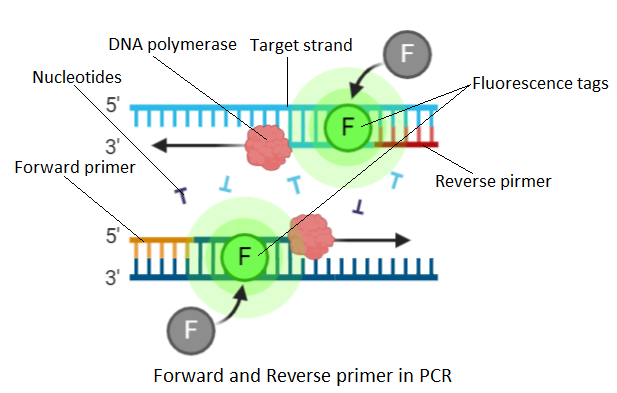
Primers (forward and reverse) are synthetic oligonucleotides of 17-30 nucleotides. They are complementary to the sequence present on the desired DNA segment. Why?
Answer
453.3k+ views
Hint: The primers are an essential component required for the replication process of DNA. Primers are small segments of nucleotides that have complementary bases to the target stand to which they attach. It is known that two strands of DNA are attached to each other due to their complementarity. Primers also use the principle of complementarity.
Complete answer: Primers are short stretches of nucleotides ranging from 17-30 base pairs. These nucleotides have a sequence opposite to the strand of DNA to which they attach or bind. Primers are initiators for the replication process. Replication occurs to make copies of DNA and to form new DNA strands inside the nucleus. Replication occurs with the splitting of two strands of DNA. The double-stranded DNA splits into two individual strands making a replication fork. Each strand serves as a template for the formation of new DNA. For the synthesis of a new strand, an enzyme called DNA polymerase adds nucleotide bases complementary to the target strand which needs to be replicated. DNA polymerase needs a primer to initiate the extension process. Primer is the initiator molecule that binds to the starting point of DNA and then DNA polymerase adds nucleotides from the 3' end of the primer.

DNA polymerase adds bases only to existing sequences and thus primers are necessary for the replication process. Primers are also designed synthetically in PCR reactions. Every DNA sequence has a specific primer for it.
Note: In polymerase chain reaction each of the separated strands of DNA is supplied with start and end primers. These are called forward and reverse primers respectively. The DNA polymerase adds bases to these primers and initiates the extension of both primers towards each other. This results in copies of the target DNA.
Complete answer: Primers are short stretches of nucleotides ranging from 17-30 base pairs. These nucleotides have a sequence opposite to the strand of DNA to which they attach or bind. Primers are initiators for the replication process. Replication occurs to make copies of DNA and to form new DNA strands inside the nucleus. Replication occurs with the splitting of two strands of DNA. The double-stranded DNA splits into two individual strands making a replication fork. Each strand serves as a template for the formation of new DNA. For the synthesis of a new strand, an enzyme called DNA polymerase adds nucleotide bases complementary to the target strand which needs to be replicated. DNA polymerase needs a primer to initiate the extension process. Primer is the initiator molecule that binds to the starting point of DNA and then DNA polymerase adds nucleotides from the 3' end of the primer.

DNA polymerase adds bases only to existing sequences and thus primers are necessary for the replication process. Primers are also designed synthetically in PCR reactions. Every DNA sequence has a specific primer for it.
Note: In polymerase chain reaction each of the separated strands of DNA is supplied with start and end primers. These are called forward and reverse primers respectively. The DNA polymerase adds bases to these primers and initiates the extension of both primers towards each other. This results in copies of the target DNA.
Recently Updated Pages
Master Class 12 Economics: Engaging Questions & Answers for Success

Master Class 12 Maths: Engaging Questions & Answers for Success

Master Class 12 Biology: Engaging Questions & Answers for Success

Master Class 12 Physics: Engaging Questions & Answers for Success

Master Class 12 Business Studies: Engaging Questions & Answers for Success

Master Class 12 English: Engaging Questions & Answers for Success

Trending doubts
Who is Mukesh What is his dream Why does it look like class 12 english CBSE

Who was RajKumar Shukla Why did he come to Lucknow class 12 english CBSE

The word Maasai is derived from the word Maa Maasai class 12 social science CBSE

What is the Full Form of PVC, PET, HDPE, LDPE, PP and PS ?

Why is the cell called the structural and functional class 12 biology CBSE

Which country did Danny Casey play for class 12 english CBSE




